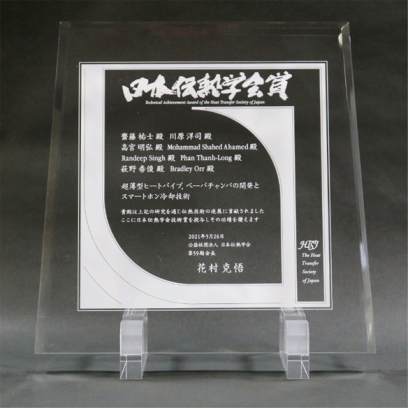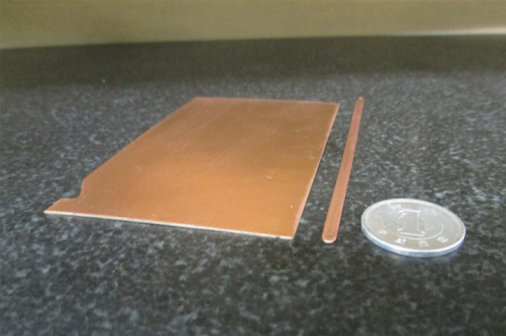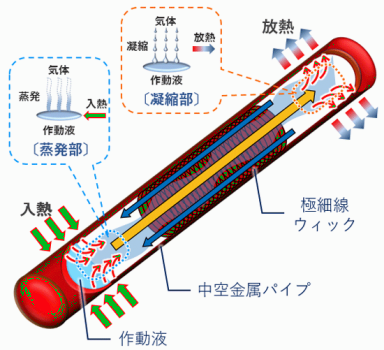Press Releases
Winner of the 2020 Japan Society of Heat Transfer Technology Award for development of thin heat pipe and vapor chamber
June 10, 2021
Fujikura Ltd.
Fujikura Ltd. (Director, President and CEO Masahiko Ito) is pleased to announce that eight members of the Next Generation Product Development Center in the Company's Electronic Components business units, led by research representative Yuji Saito, have received the 2020 Japan Society of Heat Transfer Technology Award for their development of a thin heat pipe and vapor chamber.
This award is one of four society awards given by the Japan Society of Heat Transfer and is given to those who have developed outstanding heat transfer technology that has been made public.
|
|
Award-winning members
・Electronic Components business units Next Generation Product Development Center: Yuji Saito
・Electronic business units, Thermal Solution business, Development Group: Yoji Kawahara, Phan Thanh Long, Harutoshi Hagino, Bradley Oh
・Electronic business units Thermal Solution business, Technology Group: Akihiro Takamiya, Ahmed Mohammed Shahed, Singh Randeep
Background of the award
Our thin heat pipes and thin vapor chambers use our heat transfer technology in heat pipes, which easily evaporate and condense by transferring heat. Despite their compact size, they have excellent heat transfer performance that quickly dissipates heat generated by electronic devices. This has been made strong point / feature largely by our unique wick structure applied inside the product and the technology that controls the flow of vapor and liquid inside.
This award was presented in recognition of our commercialization of the thin cooling unit based on these advanced technologies, as well as our contributions to the development of heat transfer technology through our presentations at academic conferences and our track record in patent applications, etc.
|
Ultra-thin vapor chamber (left) Ultra-thin heat pipe (right) |
Recently, the performance of many mobile electronic devices, including smartphones, thin laptops, and wearable devices, has been improving. The increase in performance of these mobile devices has also led to an increase in the amount of information that needs to be processed, and the performance of data center that process this information is also improving. As this performance increases, the amount of heat generated by electronic devices and by servers used in data center tends to increase, and how to quickly dissipate that heat has become an issue.
To address this issue, we will continue to contribute to the advancement of heat transfer technology by further improving the heat transfer performance of heat pipes and vapor chambers, and by developing and commercializing compact heat transfer units with excellent cooling efficiency, thereby helping to improve the performance of a variety of equipment.
[Reference: Explanation of terms]
The Japan Society of Heat Transfer: An academic organization whose objectives are to advance the science and technology of heat transfer, disseminate knowledge, and promote exchanges among members and internationally. (http://www.htsj.or.jp/) )
Heat transfer performance: Heat transfer is the phenomenon in which heat moves from a high-temperature solid surface to a fluid (steam or liquid) in contact with it, or vice versa. The quality of heat transfer performance is determined by how much heat can be transported with how small the temperature difference is.
Wick structure: A structure that returns the liquid condensed in the cooling part of the heat pipe to the heating part of the heat pipe by capillary action through small liquid passages in the wick, circulating the fluid inside the heat pipe.
Heat pipe: A small amount of liquid is sealed inside a pipe made of a material with high thermal conductivity such as metal, and then evaporates and condenses under vacuum. As evaporation and condensation occur easily when heat is transferred, this function cools the heat-generating parts of electronic devices by utilizing the cycle of liquid evaporation (absorbing latent heat) and condensation (releasing latent heat). Generally, the thinner the heat pipe, the smaller the cross-sectional area becomes, and the weaker the circulation force becomes, resulting in a decrease in heat transfer performance. However, using our many years of know-how and technical capabilities, we have developed a thin heat pipe that can maintain high heat transfer performance, and have been the first in the world to successfully mass-produce it.
|
How heat pipes work |
Vapor chamber: A plate-shaped chamber that replaces the function of a heat pipe, allowing it to take on more complex shapes.
Related site: "Fujikura's Heat Pipe Vapor Chamber"





